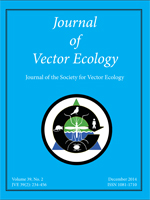We investigated the spatial and temporal distribution of blackfly larvae on a mesohabitat scale atfour different breeding sites in the Brazilian savannah “Cerrado.”A total of 2,385 larvae of 12 different species were collected, and three of the sampling sites revealedspecies richness and diversity peaks in April. A principal components analysis was performed to reduce abiotic data into a smaller set of independent variables, such as precipitation and river size, and subsequent linear regressions showed that Simulium subpallidum was positively correlated with precipitation.This species, along with S. nigrimanum, was negatively correlated withriver size, whereasS. perflavum was negatively correlated with precipitation. Beta diversity was negatively correlated withprecipitation, and black fly taxocenoses were markedly different between wet and dry seasons, as shown through nonmetric multidimensional scaling, suggesting that precipitation playsa major role in structuring these communities, probably because of enhanced drift and the dendritic nature of lotic metacommunities.
How to translate text using browser tools
1 December 2014
Seasonal Variation in Black Fly (Diptera: Simuliidae) Taxocenoses from the Brazilian Savannah (Tocantins, Brazil)
Ronaldo Figueiró,
Marilza Maia-Herzog,
Leonardo H. Gil-Azevedo,
Ricardo F. Monteiro
ACCESS THE FULL ARTICLE
It is not available for individual sale.
This article is only available to subscribers.
It is not available for individual sale.
It is not available for individual sale.

Journal of Vector Ecology
Vol. 39 • No. 2
December 2014
Vol. 39 • No. 2
December 2014
beta diversity
black flies
Cerrado
Precipitation
seasonal distribution




